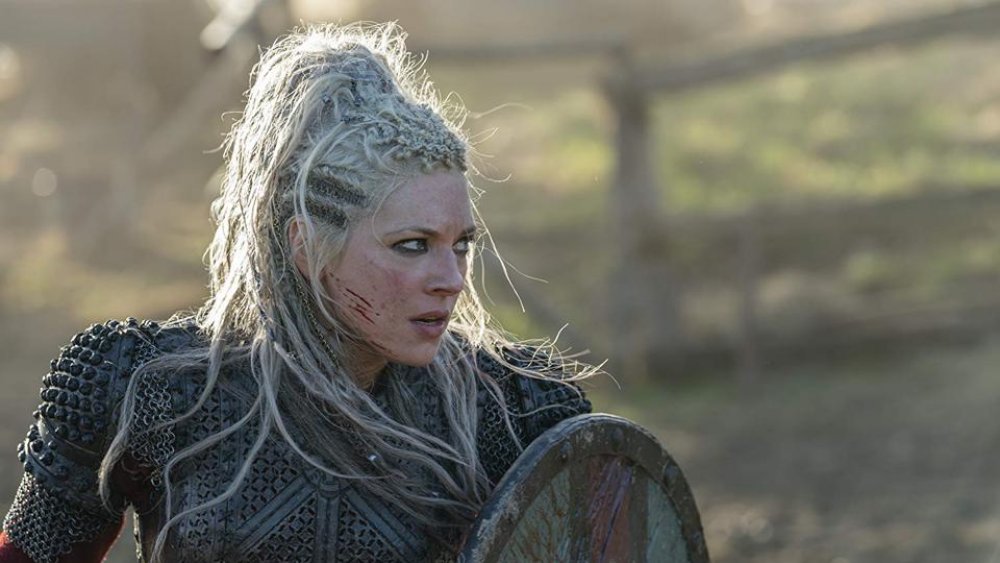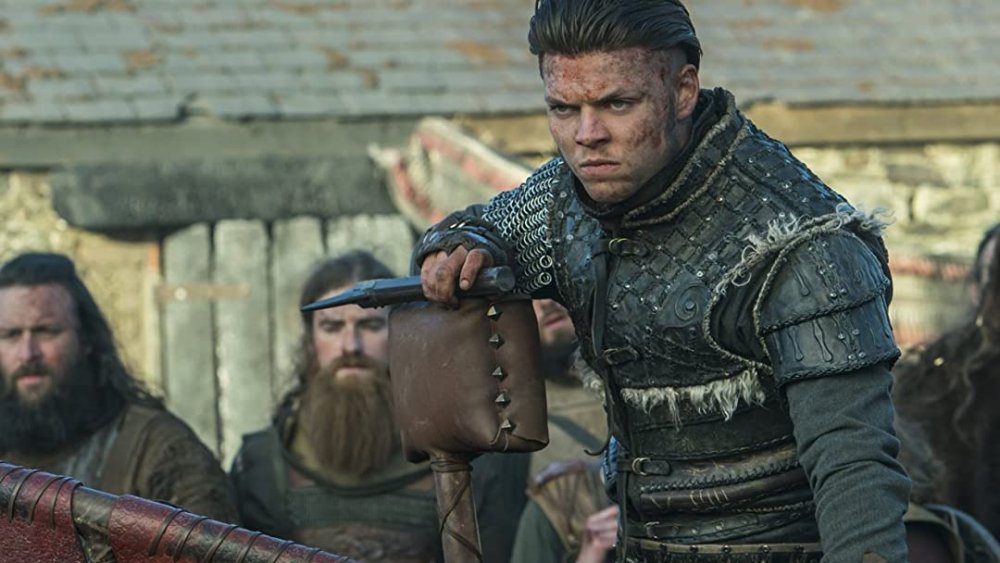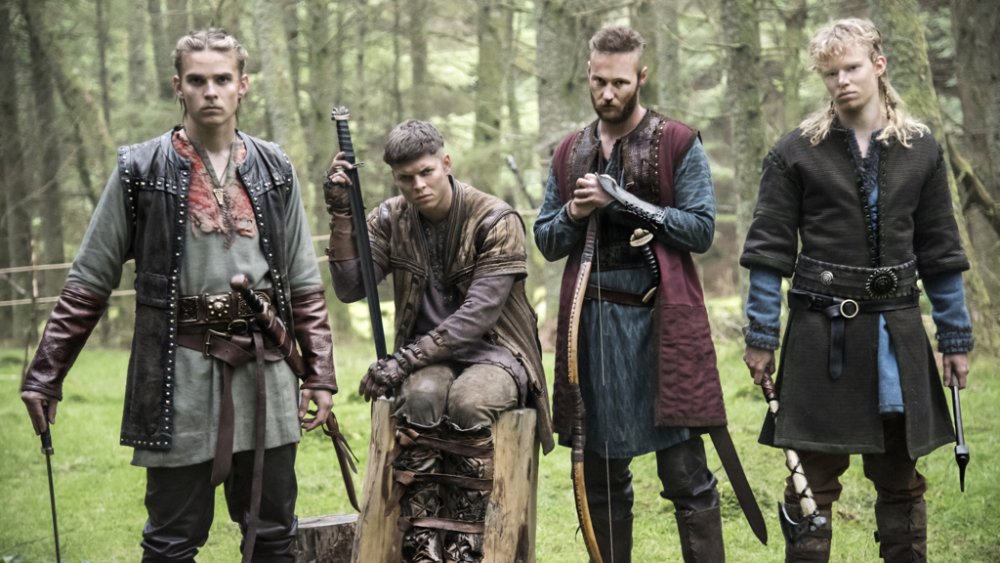Is The Vikings TV Series Based On History?
With Michael Hirst's historical epic, Vikings, approaching its final act, it's a good time to reflect on some of the open questions swirling around the series — like how "historical" this costume drama actually is.
Most viewers understand that historical fiction requires some amount of creative invention to make the story work. This is especially true when we're talking about a story from the Dark Ages, since the historical record from this time period just isn't anywhere near complete enough to float a meticulous dramatization made up exclusively of verifiable details. The events that Hirst's series purports to bring to the screen supposedly took place over 1200 years ago, during a time period after the fall of Rome in which European peoples got pretty bad at writing things down.
That said, Michael Hirst has used a scaffolding of available history to prop up his popular show. Many of the characters on Vikings — including the Lothbroks, the shieldmaiden Lagertha (Katheryn Winnick), Queen Aslaug (Alyssa Sutherland), Duke Rollo (Clive Standen), King Ecbert (Linus Roache), and Alfred the Great (Ferdia Walsh-Peelo) — have at least some basis in the historical record. Similarly, major series' events are also culled from historical sources. The raid at Lindisfarne, the Great Heathen Invasion, the Viking raid on Paris — even Ragnar's death in a pit of venomous snakes — none of these events were purely Hirst's invention. The real questions are whether the historical accounts of this time are even accurate, and just how much liberty Hirst took when stitching them together into a cogent narrative.
So is Vikings based on history? The answer is, "Yeah, kinda, but mostly no."
History's Vikings begins with a historical event
One of the most important (and brutal) events of season 1 is actually one of the better documented historical events in the series. Ragnar Lothbrok's raid on the Northumbrian monastery on the Island of Lindisfarne has substantial historical evidence for its occurence, and is considered by most historians to mark the official beginning of the Viking Age. Placing the legendary Ragnar at the head of that raid was a fanciful convenience for Hirst's story, but the raid itself seems to closely track the historical record.
In 793, Scandinavian raiders (more likely Danes than Norwegians) landed a longship at Lindisfarne and "attacked the sacred heart of the Northumbrian kingdom" (via English Heritage). A contemporaneous account of this raid exists in the Anglo-Saxon Chronicle, an Old English source that provides our most reliable record of the time period beginning with the rise of Wessex and ending in a unified England. This presented a problem for Hirst, however, since he wanted to tell the Scandinavian side of the story. The Anglo-Saxon Chronicle undoubtedly frames most of the events of the time in the light most favorable to the Christian Saxons. While Hirst could certainly use the more thorough Chronicle to check his events and provide information that might serve the historical veracity of his series, in order to tell a truly Scandinavian history, he needed an authentically Scandinavian source. Therein lies the problem.
According to an interview with History Extra, Hirst and his historical advisor on the series turned to a loose collection of fragmentary epic poetry called the sagas to try and understand the Scandinavians' view of themselves. For many reasons, the Norse sagas make for far more dubious historical sources than the Anglo-Saxon Chronicle. They were largely authored in the 13th century, hundreds of years after the events of Vikings. They also resemble myths more than historical records, and many contemporary historians have questioned their historicity.
So some of the events depicted in the series actually happened, by all accounts. The raid at Lindisfarne and the Great Heathen Invasion led by Ragnar's sons almost certainly defined the Viking Age in England. With that said, however, everything Hirst used to fill in the blanks between these events is historically questionable.
Were Ragnar Lothbrok and his sons real people?
This is a tricky answer, but bear with us here. Some of the Viking leaders considered sons of Ragnar in later sources were likely real figures. We have enough contemporaneous references to Ivar the Boneless, Bjorn Ironside, and Ubbe in the Anglo-Saxon Chronicle to accept that these three warlords actually existed and actually invaded England with a massive horde of Scandinavian soldiers. Whether they were actually biological siblings is another matter entirely, and the fact of their famous parentage may be the most unlikely claim of all.
"There's still some controversy about whether Ragnar was real or not," Hirst told History Extra. "His name does occur in several accounts, which would have been written by Christian monks in France and Ireland and England. His name crops up, often in different places at the same time, so there is substantial evidence."
Ragnar Lothbrok — the main character who instigates all the drama on Vikings — may not even have existed. Some historians actually suggest that the famous Viking king should be read as a folk hero or demi-god, a sort of mythological character who defines a shared culture.
It's entirely possible that Viking warlords of the time claimed descent from a mythical Ragnar in the same way Athenian heroes claimed descent from Zeus or other Olympians. In the Punic world, political leaders frequently claimed heritage from Heracles or Ba'al Hammon. This was a standard practice in antiquity, and likely continued far into the Middle Ages. These claims of mythological parentage may actually be the source of our confusion. Because the historical record of the time is so sparse, we may never know the truth of the matter, though it's hard to imagine Hirst's pat arrangement of these figures into one nuclear family actually has any basis in historical fact.
As the creator himself puts it, "In any case, even if [Ragnar] didn't exist it was necessary that he did for the story, for my saga that I was going to tell."
So it's hard to square Vikings with the extant historical account. The series contains too much invention and reordering of events. The account we do have, and which Hirst relied upon, however, does have quite a bit of breathing space for a creator to inject his own ideas. That seems to be the approach that Hirst took, using history and the sagas more as inspiration than a sacrosanct blueprint. Considering his series' success, it seems like he made the right call.


